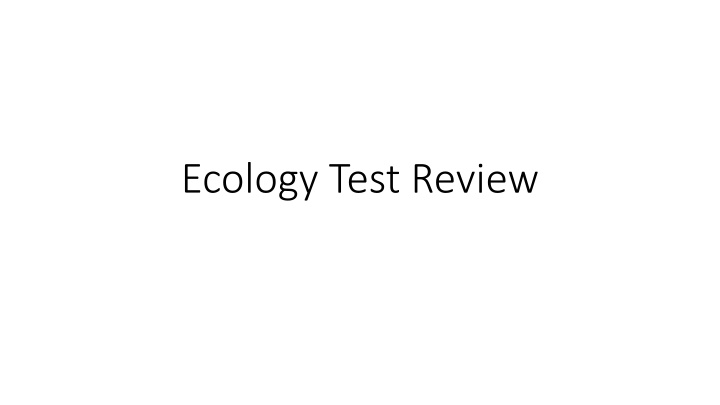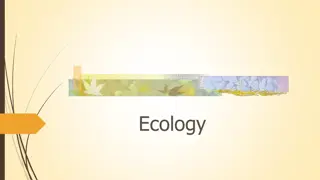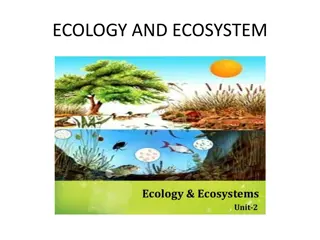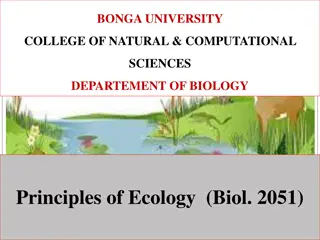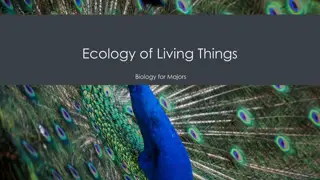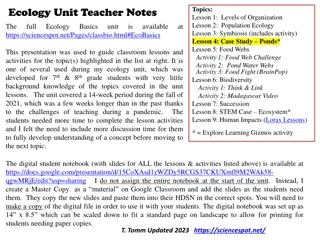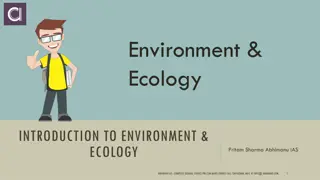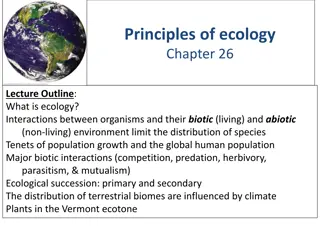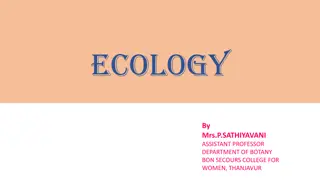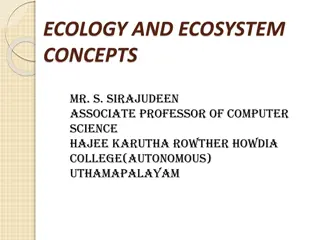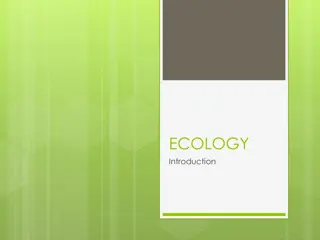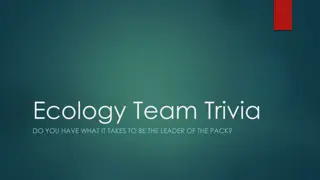Ecology Test Review Questions and Answers
Test your ecological knowledge with these questions covering topics like organism interdependence, symbiotic relationships, energy flow in ecosystems, and more. Explore concepts of commensalism, mutualism, and parasitism while learning about the roles of different organisms in maintaining ecosystem balance.
Download Presentation

Please find below an Image/Link to download the presentation.
The content on the website is provided AS IS for your information and personal use only. It may not be sold, licensed, or shared on other websites without obtaining consent from the author.If you encounter any issues during the download, it is possible that the publisher has removed the file from their server.
You are allowed to download the files provided on this website for personal or commercial use, subject to the condition that they are used lawfully. All files are the property of their respective owners.
The content on the website is provided AS IS for your information and personal use only. It may not be sold, licensed, or shared on other websites without obtaining consent from the author.
E N D
Presentation Transcript
Question 1 All of the organisms in a typical ecosystem are interdependent, helping to maintain the equilibrium of the ecosystem and sustaining each other. Which of the following processes can bacteria perform that is not possible for the other members of a typical ecosystem? A converting radiant energy into chemical energy B conserving water C using nitrogen from the atmosphere D balancing carbon dioxide levels
Question 2 When barnacles attach themselves to a whale, the whale is not usually positively or negatively affected. The movement of the water past the swimming whale carries food particles to the barnacles. This situation is an example of A commensalism B mutualism C parasitism D predation
Question 3 Hermit crabs live inside shells produced by other organisms. Sea anemones often attach to the top of a hermit crab's shell. When the crab moves, the shell, including the anemone is carried to a new location. There may be additional food resources at this location. Most predators of hermit crabs avoid sea anemones. Which symbiotic relationship best describes the hermit crab and sea anemone? A parasitism B commensalism C mutualism D competition
Question 4 In autumn, leaves from deciduous trees change color due to environmental abiotic conditions. Which of the following explains this phenomenon? A Decreasing moisture causes closing of the stomata controlling gas exchange. B Decreased light levels decreases the production of chloroplasts. C Increasing moisture increases the production of sap. D Increasing light levels increase the levels of meristematic tissue in the stem.
Question 5 The fly Ormia ochracea is attracted to the sound of the male cricket, using it to locate the male in order to deposit her young on him. The larvae promptly burrow into the cricket and eat him. What symbiotic relationship does this illustrate? A parasitism B commensalism C mutualism D competition
Question 6 Which of these organisms provides the most energy in a typical forest ecosystem? A birds B lynx C moose D trees
Question 7 In the biomass energy pyramid to the right, which level contains 1% of the energy from the producer? A Oak Tree B Blue tit C Caterpillar D Sparrowhawk Biomass Sparrowhawk Blue tit Caterpillar Oak Tree
Question 8 Some plants have very long taproots. This adaptation helps these plants survive in a A. temperate forest by needing very little water B. tundra by taking water from below the permafrost C. prairie by absorbing large amounts of surface water D. desert by reaching deep underground water supplies
Question 9 According to this food web to the left, which of these does not eat producers? A frog B moose C rabbit D mice
Question 10 Like other vultures, the king vulture is a scavenger. These large birds glide on air currents, conserving energy while searching the forests or savanna below for the corpses of dead animals. Because of their unappetizing eating habits, they fill an ecological niche, and may help to prevent the spread of disease by disposing of rotting remains. In this food web, the vulture takes on the role of a: A Producer B Detritivore C Secondary Consumer D Primary Consumer
Question 11 Which cycle would be affected to the greatest extent by the destruction of the Earth s huge rainforests? A water cycle B carbon cycle C nitrogen cycle D None of these is greatly affected
Question 12 In this ecosystem, the algae are A producers B consumers C decomposers D recyclers
Question 13 Which of the following describes the correct energy flow in an ecosystem? A Energy flows from heterotrophs to autotrophs to decomposers. B Energy flows from decomposers to consumers to producers. C Energy flows from producers to consumers to decomposers. D Energy flows from producers to decomposers to consumers.
Question 14 The highest concentration of life exists in the top 200 meters of ocean water. Consider energy flow in this ecosystem. The most important factor that influences this concentration of life is the A amount of gases at the surface. B amount of nutrients in the water. C large number of predators at lower depths. D amount of sunlight
Question 15 A chemical spill kills all of the nitrogen-fixing bacteria in an ecosystem without directly harming any other organisms. Which of the following processes in plants will be affected first as a result of the loss of these bacteria? A. Production of oxygen B. Production of sugars C. Production of water D. Production of amino acids
Question 16 Thick fleshy stems with thick waxy covering would most likely be useful adaptations for which of the following types of plants? A. desert plants that need to conserve water B. tundra plants that need to conserve heat C. prairie plants that need to survive fires D. rainforest plants that need to repel insects
Question 17 Various processes and events occur during ecological succession. Which one of the following does not occur during succession? A. environmental changes B. replacement of one community by another C. increase in population size followed by a decrease in population size D. decreased species diversity
Question 18 How will rapid environmental change impact the stability of an ecosystem? A. It will make the ecosystem less stable. B. It will make the ecosystem more stable. C. It will not impact the stability of the ecosystem. D. It will help the ecosystem attract more animals.
Question 19 Under favorable conditions, a population will grow in size. Look closely at the graph which shows the growth of a population over time. Why did the population stop growing? A. The reproductive rate increased. B. Resource bases such as food are limited. C. The individual exhibited more adaption to their environment. D. The carbon and nitrogen cycles stopped operating
Question 20 In a desert, water is limited. Which species described below is most likely to survive? A. Large animal that begins to sweat profusely when overheated. B. A plant lacks vascular tissues instead relying on osmosis to get water. C. A small nocturnal rodent has efficient kidneys that able to retain water and filter salt. D. A large carnivorous mammal has a coat made up of hollow hairs enabling retention of body heat.
Question 22 In Texas, the Prairies & Lakes (Backland Prairies) ecosystem is often characterized with grasslands intermingled with oak & hickory forests. Grass seedlings require large amounts of sunlight to grow, while oak seedlings don t. Based on that information what statement is most likely true? A. Over time, forested land will become grassland. B. Over time, grassland will become forested land. C. Over time, forested land will remain forested land D. Over time, grassland will remain grassland
Question 23 The family Elephantidae contains both living and extinct species of the largest land mammal on earth. Of the most well-known extinct species is the tundra mammoth. The largest Tundra mammoth ear ever discover measured only 12 inches long. The living African elephant has ears measuring 71 inches. What is the most likely explanation for the variations in ear length of these species? A. difference in diet led to smaller sized individuals. B. differences in climate led to distinctive body shape C. the process of fossilization caused the appendages of the mammoth to shrink D. living tissues are full of water thus swell to a larger size
Question 24 The Nile River flows into the Mediterranean Sea. The Aswan High Dam contains the flow of water from the river and reduces the annual fall flooding. The floodwater is trapped behind the huge dam, allowing irrigation for agriculture. Sediments that would be washed away by the annual floods are also trapped behind the dam. The graph shows the water flow from the Nile that enters the Mediterranean Sea. How has this dam most likely affected the Mediterranean Sea ecosystem? A. Reduced nutrients from the land support fewer producers in the sea. B. Water trapped behind the dam causes the marine ecosystem to move inland. C. The flooding in August through November causes marine life to be destroyed. D. The water temperature of the sea has increased.
Question 25 The iris controls the size and shape of the pupil. Which eye most likely belongs to an animal that is active most of the day on white desert sand?
Question 26 In biological terms, what does succession mean? A. A descendent of animal breeding. B. The result when one species is more successful than another. C. The gradual process of change in an ecosystem brought about by the progressive replacement of one community by another until a stable climax is established. D. There is no biological succession
Question 27 Why are food chains so short, rarely going higher than through 45 organisms instead of 8 or more trophic levels? A The digestive systems of carnivores cannot handle foods in a widely varied diet. B The number of species available for consumption is very limited in most ecosystems. C There is too little energy left at higher trophic levels to make consumption worthwhile. D There are just not enough animals present in ecosystems for really long food chains.
Question 28 Various processes and events occur during ecological succession. Which one of the following does not occur during succession? A. environmental changes B. replacement of one community by another C. increase in population size followed by a decrease in population size D. decreased species diversity
Question 29 The chestnut lamprey is a jawless native fish that can attach its mouth to the side of another fish, such as a lake trout. The lamprey releases a substance that prevents the lake trout's blood from clotting and uses its tongue to create suction that draws a steady flow of blood and body fluids from the lake trout. This type of lamprey rarely kills the lake trout before detaching and moving on. The relationship between a chestnut lamprey and a lake trout can best be described as A commensalism B mutualism C predation D parasitism
Question 30 The Nile crocodile opens its mouth to permit the Egyptian plover to feed on any leeches attached to its gums. Which type of symbiosis is this? A commensalism B mutualism C predation D parasitism
